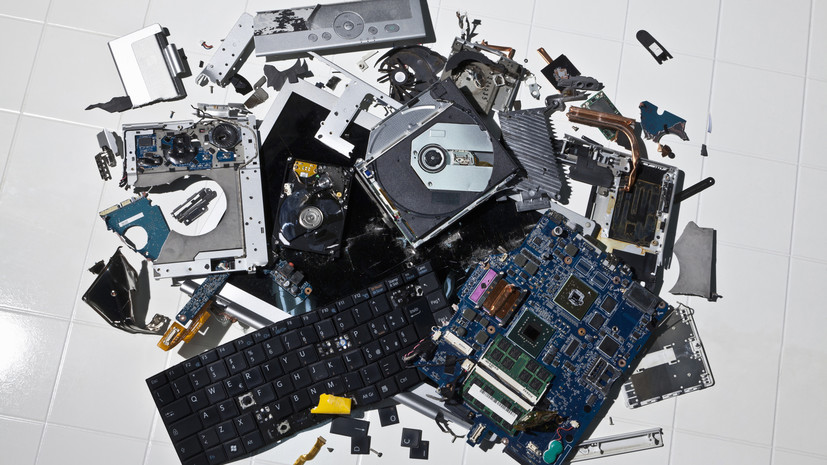— On January 1, new waste disposal rules, previously approved by the government, came into force. The new list of waste to be recycled includes 780 new items, including construction products, textiles and electronic equipment. I would like to discuss in detail the recycling of electronics and household appliances - how large is its share in the total volume of waste?
— According to retail chains, in recent years the volume of sales of home electrical equipment and gadgets on the Russian market amounted to 12.5 kg per capita. At the same time, 11–12 kg turns into waste, most of which is represented by large household appliances - washing machines, vacuum cleaners, heaters, etc. Some of it is sent for recycling. According to the Russian Ecological Operator PPK, about 1.5 million tons of waste electronic and electrical equipment (WEEE) are generated annually in Russia, and less than 5% are recycled.
Thus, research conducted by the Department of Environmental Protection of PNRPU showed that in the Perm region, every person annually throws 1–1.5 kg of electronic waste into a trash container. As a rule, these are small household appliances. Subsequently, it is sent for disposal to MSW landfills. Large devices are stored separately on container sites, and no one knows this figure for the region.
People are using more and more household appliances, which is causing an increase in the generation of electronic waste. The lifespan of telephones and small household appliances is reduced.
— Why shouldn’t electronics be thrown away with household waste?
— Electronic devices are multi-component waste that is difficult to disassemble and dispose of. They contain ferrous and non-ferrous metals, as well as plastics and glass, which practically do not rot. Under normal conditions they are harmless, but under the influence of heat, cold and precipitation in a landfill they begin to decompose. Metal from circuit boards and microcircuits oxidizes, releasing toxic substances. At the same time, the bulk of electronics still belongs to low-hazard waste for the environment. Some types of cartridges and mobile phones are considered moderately dangerous. Batteries for gadgets - smartphones, laptops, cameras - belong to the highly hazardous class of waste. Nowadays, lithium-ion and lithium-polymer batteries are most often used. They contain cadmium, chromium, lead and lithium, which are harmful to the environment and humans if the battery ends up in a landfill after use.
Gettyimages.ru
© iStockVadim
— Many people are already aware that they should not throw away batteries; there are many collection points for used batteries. How do they affect the environment if they end up in nature?
- Yes,
Salt batteries (or zinc-carbon) are also classified as highly hazardous waste. To increase their corrosion resistance, manufacturers use cadmium or lead in them. Salt batteries, as a rule, are not marked and are used in TV remote controls, watches, scales, and electronic thermometers. Alkaline batteries of the same hazard class (marked “L”) have higher power and are used in cameras, players, computer mice, and mobile phones. When they decompose, toxic gases are also formed that, if released into the soil and water, can disrupt the ecosystem. Of course, there are waste sites equipped with special protection that does not allow toxic compounds to penetrate beyond its boundaries. This allows us to minimize the burden on the environment. However, not all landfills in the world are equipped with such systems. What is also important: when electronic devices are thrown away, very valuable materials are lost.
— What main components of electronics and household appliances are of interest for reuse?
— Any electronic device that will sooner or later become waste includes precious metals (gold, silver, platinum), rare earth elements (ruthenium), critical (lithium, palladium) and non-ferrous metals (copper, aluminum). Since 2017, Russia has had a ban on the disposal of waste containing useful components. Such waste also includes used consumer equipment. From September 1, 2023, requirements for the management of electronic and electrical waste were introduced. For example, separately assembled equipment in an electronics store will be recycled without fail.
Gettyimages.ru
© Marco Vacca
— What solutions can reduce the loss of materials from equipment emissions, as well as environmental damage?
— In general, since March 2022, Russia has introduced fines for throwing away gadgets, computers and household appliances. For a violation, an ordinary citizen will pay from 1 to 4 thousand rubles, a legal entity - from 100 to 500 thousand rubles. In general, the population has already formed an understanding that such things cannot simply be thrown away. If a person knows where to donate old equipment, he will probably do it.
At the same time, it is necessary to develop not only networks for receiving non-working equipment, but also networks of repair shops and so-called repair cafes - equipped spaces where people can repair things on their own. What else to do with old equipment? If it is still in working order, then you can sell it at a reduced cost or give it away for free if profit is not important to you. In addition, you should try to use the device for as long as possible and not buy a new one. If it is obsolete or no longer liked, give it away or sell it to someone else who needs it. If the gadget breaks down, repair it.
Gettyimages.ru
©DragonImages
And for this it is important that electronics manufacturers produce repairable and compatible equipment. One of the requirements of modern eco-design is the creation of electronics with updated and thoughtful software, each update of which does not require changing a computer or smartphone, because “there is not enough memory.” The same applies to chargers, which must be unified for many gadgets.

